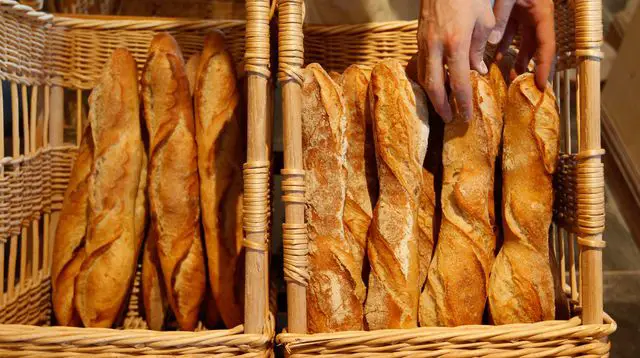 Today wasn’t the first time I’ve done it… bought a fresh baguette, still warm from the local boulangerie, cut a bit off ‘just to try it’, smeared it well with butter and, half-an-hour later, looked at the pile of crumbs on the worktop where the baguette used to be. There’s something about genuine French baguettes that brings out the food devil in me.
Today wasn’t the first time I’ve done it… bought a fresh baguette, still warm from the local boulangerie, cut a bit off ‘just to try it’, smeared it well with butter and, half-an-hour later, looked at the pile of crumbs on the worktop where the baguette used to be. There’s something about genuine French baguettes that brings out the food devil in me.
If I asked you to name the five most iconic foods of France, I could virtually guarantee you’d include the humble baguette. They’re one of the most instantly recognisable foods around the world, and usually the best part of any trip to France. They’re also so dangerously tasty that you might like to do what I do and buy an extra one, since you’re probably going to eat one on the walk home from the boulangerie!
It might surprise you to know that, until just a few years ago, boulangers in Paris had to stagger their summer vacations. The idea of all of the bakeries closing at the same time is the stuff of nightmares to your average French citizen. So, the law stated that each year, half the bakers could go on vacation in July, and the other half in August. French people take their bread VERY seriously, and the baguette is the king of the baker’s jungle.
The baguette’s shape comes from a one hundred-year-old law to reduce working hours. To help keep boulangers from overworking (as if they would, in France!), in 1920 the government passed a law forbidding them from starting their shifts before 4am, or from working past 10pm at night.
But dough takes time to rise, and bread takes time to bake, so if you’re only allowed to start your day at 4am, what do you do? You create the baguette! The long, thin shape of the loaf exposes as much of the dough to heat as possible, meaning it bakes faster. This way, your bakery can pump out the same number of loaves in less time. Now that is French ingenuity at its finest.
There are even strict laws about the length and weight of a baguette! If it’s not 55cm-65cm long and doesn’t weight 250g-300g it’s doesn’t qualify to be called a baguette. Also, the boulangers are only allowed to use four ingredients – flour, yeast, salt, and water. Naturally, they can vary the quantities of each, and they can use different flours to achieve different tastes. And if they are claiming to be an ‘artesanal bakery’ they must sell their baguettes in the same place where they bake them.
France is even trying to get the baguette recognised by UNESCO as part of their cultural heritage. The French people love bread, dammit. In fact, one of my early memories after I moved to France to be with Marie-Danielle, was of getting up on a Sunday morning and going to a boulangerie in the small village where we were staying. Imagine my surprise when I saw a long queue outside the shop. It was as though the whole village had turned out to buy bread.
 In 1900, the average French person ate more than three baguettes every day. By 1970, that number had fallen to just one baguette per day. And these days, people eat just half a baguette on a daily basis. Now, half a loaf of bread every day might still seem like a lot of white bread to consume. But for the French of the early 20th century, that would be heresy!
In 1900, the average French person ate more than three baguettes every day. By 1970, that number had fallen to just one baguette per day. And these days, people eat just half a baguette on a daily basis. Now, half a loaf of bread every day might still seem like a lot of white bread to consume. But for the French of the early 20th century, that would be heresy!
The baguette is probably safe from ever dying out, though. It’s one of the most loved and easily recognisable breads from around the world, and still at the top of every traveller’s bucket list when they go to France! Just one small tip; ask for ‘une baguette tradition’, or simply ‘une tradition’ and you’ll get a nice country baguette, full of taste.
 Jasmine Guichard didn’t want Father Barbier touching her. She’s a plucky eight-year-old and she makes a run for it, but finds herself deep under the streets of Paris and lost in a maze of dark tunnels. But for a chance glimpse of her whilst visiting the catacombs, Harry and Tristan would have been none the wiser. Yet what can they do about it? They are eventually helped in their efforts by a young nun who is not at all what she seems. There’s more going on behind the closed doors of the Daughters of Charity of Saint Isabelle of France than meets the eye – a lot more.
Jasmine Guichard didn’t want Father Barbier touching her. She’s a plucky eight-year-old and she makes a run for it, but finds herself deep under the streets of Paris and lost in a maze of dark tunnels. But for a chance glimpse of her whilst visiting the catacombs, Harry and Tristan would have been none the wiser. Yet what can they do about it? They are eventually helped in their efforts by a young nun who is not at all what she seems. There’s more going on behind the closed doors of the Daughters of Charity of Saint Isabelle of France than meets the eye – a lot more.